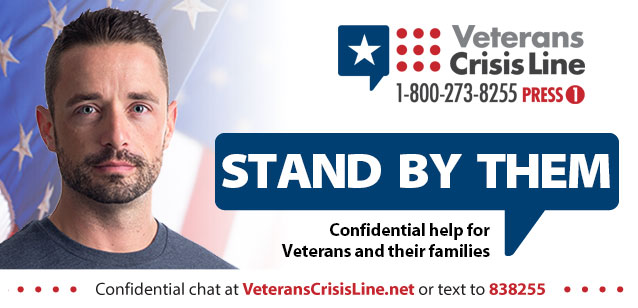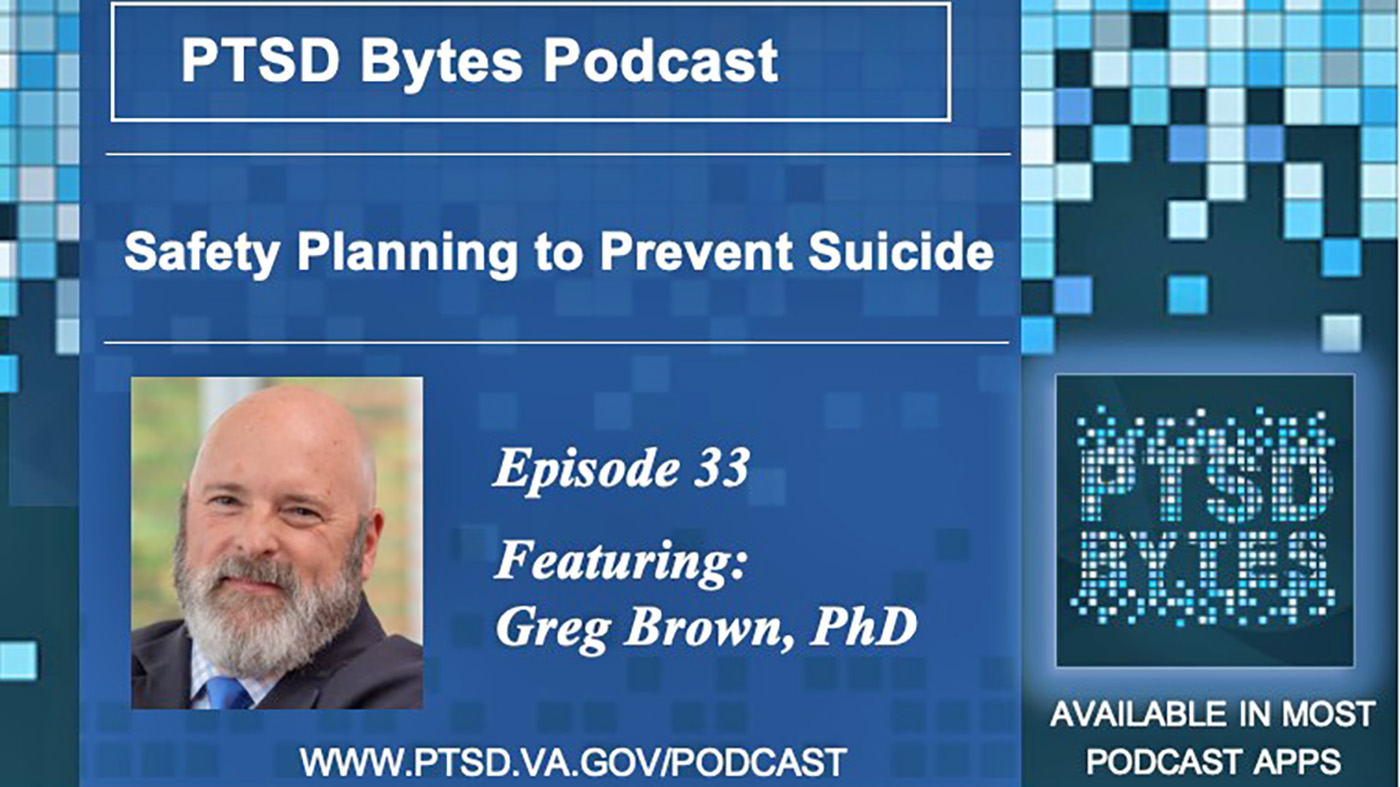VA’s Crisis Line number is:
1-800-273-8255. Press “1” for Veteran services
Veterans Chat can be accessed at www.VeteransCrisisLine.net
Veterans Text is available at 838255
Every Veteran suicide is a tragic outcome and regardless of the numbers or rates, one Veteran suicide is too many. We continue to spread the word throughout VA that “Suicide Prevention is Everyone’s Business.” Although we understand why some Veterans may be at increased risk, we continue to investigate and take proactive steps. The ultimate goal is eliminating suicide among Veterans.
VA relies on multiple sources of information to identify deaths that potentially are due to suicide. This includes VA’s own Beneficiary Identification and Records Locator Subsystem (BIRLS) and data compiled by the National Center for Health Statistics in its National Death Index. In addition, we request current information directly from each State and maintain our own databases of known events and completions.
These sources give us specific indications about Veteran vulnerability to suicide:
- Approximately 40,000 US deaths from suicide per year among the population overall (Centers for Disease Control and Prevention) Approximately:
- 22 percent of those who die by suicide are Veterans (VA Suicide Data Report, 2012).
- 42 percent increased risk for suicide among users of VHA services when compared to rates of suicide in the US general population (VA Serious Mental Illness Treatment, Research and Evaluation Center, 2011).
- 5 suicide related deaths per day among Veterans receiving care in the Veterans Health Administration (VHA) (VA Serious Mental Illness Treatment, Research and Evaluation Center).
- 1,300 suicide deaths, attempts, and reports of serious ideation per month among Veterans receiving care reported to Veterans Health Administration (VHA) suicide prevention coordinators (2014).
- 14 percent of those who have a reported suicide event in fiscal year (FY) 2011 (and did not die as a result of the event) had a report of a repeat suicide event within the next 12 months. Among those who survived their first suicide attempt and reattempted suicide within the next 12 months, less than one percent died from suicide (VA Suicide Data Report Update, 2014).
- Preliminary evidence suggests that since 2006, there are decreased suicide rates in Veterans (men and women) aged 18-29 who use VA health care services relative to Veterans in the same age group who do not. This decrease in rates translates to approximately 250 lives per year (State Mortality Project). More than 60 percent of suicides among those who use VHA services are among patients with a known diagnosis of a mental health condition (Serious Mental Illness Treatment Research and Education Center). Veterans are more likely than the general population to use firearms as a means for suicide (State Mortality Project).
In terms of specific numbers, preliminary evidence on the incidence of Veteran suicide events and serious suicide ideation can be derived from data from the VA’s Suicide Prevention Coordinator reports. While this may under represent the total number of events, it does provide important information.
FY 2014
Known Events (non-fatal, undetermined, and suicides): 15,048*
Preliminary data are also available for attempts in Operation Enduring Freedom/Operation Iraqi Freedom/Operation New Dawn (OEF/OIF/OND) Veterans:
FY 2014 OEF/OIF/OND
Known Events (non-fatal, undetermined, and suicides) 3,558*
*Among users of VHA services
Longitudinal data derived from national sources demonstrate suicide rates among male and female Veterans of particular age cohorts.
- The suicide rate is higher for men than for women; this is true for the US population (and in much of the world) as well as for Veterans.
- Overall, the highest rate for male Veterans from OEF/OIF was during FY 2004. This was the year when VA, for a variety of reasons, recognized problems in its mental health care and developed a VA Comprehensive Mental Health Strategic Plan (MHSP) to address them. Data in subsequent years, when overall mental health care was greatly enhanced, show reduced rates between the time periods FY 2005-2007 and FY 2009-2010. It is concerning that the 2011 numbers are again rising, but this can be attributed to male Veterans between the ages 18-49 years and female Veterans between the ages of 18-24 years.
- Focused suicide prevention efforts, such as the Veterans Crisis Line and hiring of Suicide Prevention Coordinators, began in FY 2007 with full implementation in FY 2008. Data needed to see the full impact of VA’s intensive efforts focused specifically on suicide prevention is emerging. Those initiatives and early indicators of change are described in detail in the following section.
Current Initiatives
VA’s basic strategy for suicide prevention requires ready access to high quality mental health (and other health care) services supplemented by programs designed to help individuals and families engage in care and to address suicide prevention in high-risk patients. Some of the initiatives that have proven to be very effective include:
- A 24/7 Veterans Crisis Line (VCL). Veterans call the national suicide prevention hotline number, 1-800-273-TALK and then “Press 1” to reach highly skilled responders trained in suicide prevention and crisis intervention. Since the Veterans Crisis Line began in 2007 through June 2015, the VCL has answered over1.86 million calls from Veterans, family members, friends, and others concerned about a Veteran. The VCL has initiated the dispatch of emergency services to callers in imminent suicidal crisis over 50,000 times. Since launching chat in July 2009 and text services in November 2011, the VCL has answered over 240,000 and 39,000 requests for chat and text services respectively. The VCL has provided over 300,000 referrals to a VA Suicide Prevention Coordinator (SPC) thus ensuring Veterans are connected to local care.
- Each VA Medical Center has a Suicide Prevention Coordinator or team. The coordinators and their teams ensure that the Veteran receives the appropriate services. Calls from the VCL are referred to the coordinators as appropriate, who follow up with Veterans and coordinate care.
- Screening and assessment processes have been set up throughout the system to assist in the identification of patients at risk for suicide. A chart “flagging” system has been developed to ensure continuity of care and provide awareness among caregivers.
- Patients who have been identified as being at high risk receive an enhanced level of care, including missed appointment follow-ups, safety planning, follow-up visits and care plans that directly address their suicidality.
- All patients who are identified as being at possible suicide risk and have been determined to be safe at the present time are seen within 24 hours by a Mental Health professional, including those who call the VCL. Patients who are not safe at the present time are immediately admitted or escorted to a safe facility.
- Reporting and tracking systems have been established to learn more about Veterans who may be at risk and to help determine areas for intervention. Continual analysis of reports and VA data has led to three information letters to the field:
- Each of the mental health conditions increases the risk of suicide. However, the effect of Posttraumatic Stress Disorder may be related separately from its co-occurrence with other conditions.
- Chart diagnoses associated with Traumatic Brain Injury are associated with increased risks of suicide, even after controlling for comorbid mental health conditions.
- Some, but not all, chart diagnoses associated with chronic pain are associated with increased risks of suicide, even after controlling for comorbid mental health conditions.
- Employee education programs such as Operation S.A.V.E. (Signs of Suicidal thinking, Ask the questions, Verify the experience with the Veteran, and Expedite or Escort to help) and a Web-based clinical training module that is mandatory for all VHA employees
- There are two centers devoted to research, education and clinical practice in the area of suicide prevention. VA’s Veterans Integrated Service Network (VISN) 2 Center of Excellence in Canandaigua, New York, develops and tests clinical and public health intervention strategies for suicide prevention. VA’s VISN 19 Mental Illness Research Education and Clinical Center in Denver, CO focuses on: 1) clinical conditions and neurobiological underpinnings that can lead to increased suicide risk; 2) the implementation of interventions aimed at decreasing negative outcomes; and 3) training future leaders in the area of VA suicide prevention.
- Each Mental Health Residential Rehabilitation Treatment Program (MH RRTP) conducts an annual Stand Down focused on safety and security as part of the Culture of Safety initiative. During the Stand Down each program suspends program operations and holds meetings and events, inviting input from program staff, Veterans, and other key stakeholders, for a focused review of current challenges related to the safety and security needs of Veterans served. The Stand Down provides dedicated time for staff to address safety and security concerns identified through review of policies, procedures, and practices throughout their continuum. In addition, the Culture of Safety initiative outlines requirements for S.A.V.E. training for all Veterans admitted to the MH RRTPs. The Culture of Safety initiative places particular emphasis on some of our most vulnerable populations, including women Veterans, Veterans at risk for suicide and Veterans diagnosed with opioid dependence.
Outreach
- VA has sponsored annual Suicide Prevention Months to increase awareness of the problem and co-sponsored three conferences on suicide prevention with the Department of Defense for clinicians in both systems.
- VA is sponsoring public service announcements (PSAs), Web sites and display ads designed to inform Veterans and their family members of VA’s Veterans Crisis Line (1-800-273-8255; press 1). All current Crisis Line PSAs, display ads, and other information are readily available at www.veteranscrisisline.net
- Suicide Prevention Coordinators are required to conduct at least five outreach activities per month in all of their local communities and are able to provide a Community version of Operation S.A.V.E. to returning Veterans and family groups, Veterans Service Organizations and other community groups as desired.
- Family psycho-educational materials have been developed including information sheets intended to serve as guides for adults to use when talking with children about a suicide attempt in the family and family Ask, Care, Escort card.
- An outreach video was developed to emphasize the importance of taking precautions at home when a firearm is present. The video is used by VA Suicide Prevention Coordinators in their community outreach and education efforts. The primary message of the video is that simple actions can help individuals and families stay safe, especially during emotional or stressful times, or when someone in the home is in crisis. This video encourages Veterans, Servicemembers, and their families to make sure guns and ammunition are safely secured in their home, particularly when someone is experiencing a period of depression or crisis. The video is available on the Veterans Health Administration YouTube page.
Research
- Suicide prevention research is challenging for many reasons. However, scientists are addressing the problem through epidemiologic studies to identify risk and protective factors, clinical and population interventions, and biological research examining brain related changes in suicidal patients.
- VA has recently developed an analytic model for predicting suicide risk. VA researchers and program officers are engaged in understanding how this information can inform outreach activities and clinical care.
- A recent comprehensive review concluded that intensive education of physicians and restricting access to lethal means had substantial evidence for preventing suicide.
- VA researchers are also engaged in efforts to ensure safety plans are in place for participants in research including coordination with the Veterans Crisis Line.
- Other approaches needing further research include screening programs, media education, and public education. Structured cognitive therapy approaches for those who are suicidal (or suicide attempters) education of what are often called community “gatekeepers,” and means of access restriction initiatives (e.g., gun locks, blister packaging medications) show promise.
Public Health Contribution to Suicide Prevention in America
- VA’s Crisis Line Center receives more than 30 percent of all calls to the National Suicide Crisis Line and provides one of the only national 24/7 suicide chat services in the world.
- VA’s Media Campaign has provided access to the National Suicide Crisis Line number to Americans nationwide.
- Suicide Prevention Coordinator Outreach work has touched many community members as well as VA employees and employee families.
For more information, Veterans currently enrolled in VA health care can speak with their VA mental health or health care provider. Other Veterans and interested parties can find a complete list of VA health care facilities, Vet Centers, their local Suicide Prevention Coordinators, and other resources under the resource section of www.veteranscrisisline.net or at www.va.gov.
Additional information
Topics in this story
More Stories
Be ready before a suicide crisis by learning about resources that are available. You don’t have to face it alone.
In a two-part series, Dr. Colleen Becket-Davenport discusses some common myths surrounding PTSD with Dr. Kelly Maieritsch.
In this episode of the PTSD Bytes podcast, we speak with with Dr. Greg Brown, Philadelphia VA clinical psychologist, about how safety planning can prevent suicide.





